Relationship Spread #1
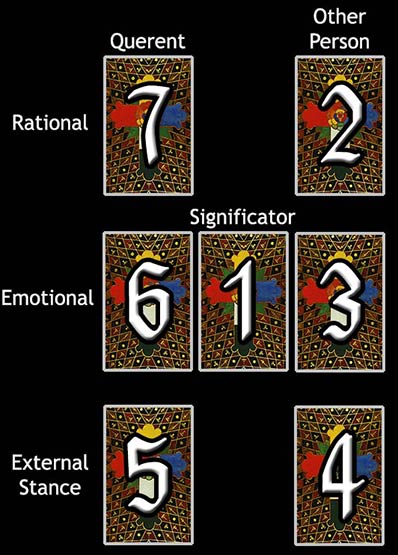
Difficulty: Easy
This tarot spread is easy to read, like a convenient chart. In this spread, court cards generally indicate actual people with the same characteristics. Knights (or corresponding princes, but not kings) and queens are meant to represent actual men and women in this tarot spread. Look for patterns in the cards as always.
Card #1 is the overall significator of the relationship. The two columns on either side of the significator characterise each individual's role in the relationship. The relationship does not have to be romantic. In fact, it could be a relationship between a person and a group, or even how two groups relate.
The top row, cards #7 & #2, is about the conscious thoughts of each person, or what they think about the relationship and likewise how they view their partner.
The middle row, cards #6 & #3, reveals the way each individual feels about the other. Emotional awareness corresponds to a person's unconscious thoughts that run deep, affecting a person in ways he or she is not fully aware of.
The bottom row, cards #5 & #4, represents the way each person behaves, in other words the stance taken regarding the relationship. The way a person acts may be genuine, but sometimes people are phony and manipulative, so it is best to weigh this card against the other person's cards to determine how they match up.
Your Relationship Reading #1 with the Book of Thoth
You |
Other Person |
||
Thought |
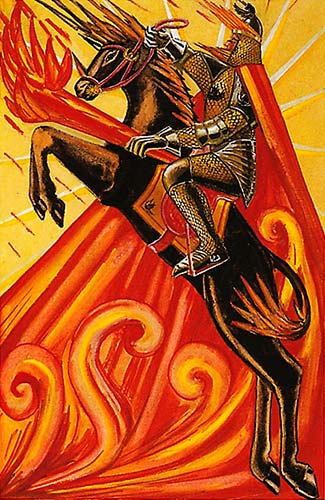 Knight of Wands |
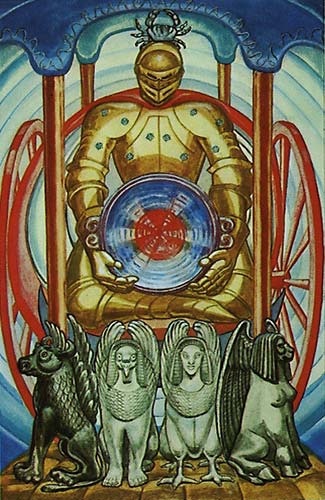 The Chariot |
|
Emotion |
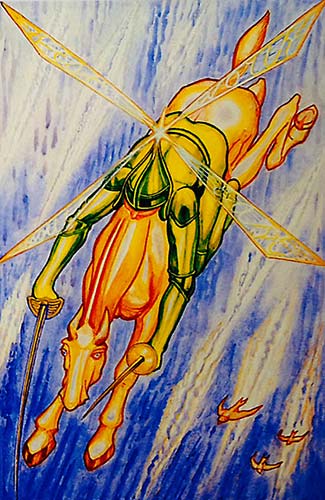 Knight of Swords |
The Significator  10 of Wands |
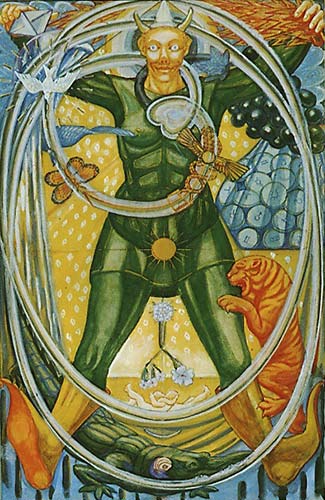 The Fool |
External Stance |
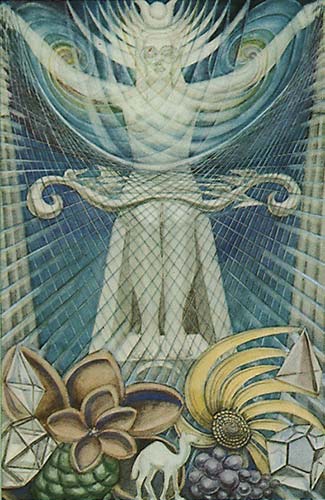 The Priestess |
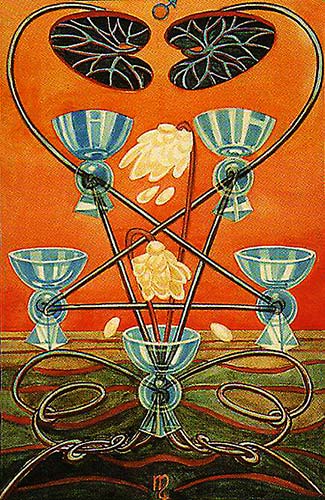 5 of Cups |

The Significator
10 of Wands
Saturn in Sagittarius – Oppression
The number Ten refers to Malkuth, which depends from the other nine Sephiroth, but is not directly in communication with them. It shows the Force detached from its spiritual sources. It is become a blind Force; so, the most violent form of that particular energy, without any modifying influences. The flames in the back ground of the card have run wild. It is Fire in its most destructive aspect.
The whole picture suggests Oppression and repression. It is a stupid and obstinate cruelty from which there is no escape. It is a Will which has not understood anything beyond its dull purpose, its 'lust of result', and will devour itself in the conflagrations it has evoked.

The Querent's Thoughts
Knight of Wands
Sagittarius
The Knight of Wands represents the fiery part of Fire. He is a warrior in complete armour. On his helmet for a crest, he wears a black horse. In his hand he bears a flaming torch; a flame also in his mantle; and upon the flames does he ride. His steed is a black horse leaping.
The moral qualities appropriate to this figure are activity, generosity, fierceness, impetuosity, pride, impulsiveness, swiftness in unpredictable actions. If wrongly energised, he is evil-minded, cruel, bigoted and brutal. He is in either case ill-fitted to carry on his action; he has no means of modifying it according to circumstances. If he fails in his first effort, he has no recourse.

The Other Person's Thoughts
The Chariot
Cancer
Triumph, victory, hope, memory, digestion, violence in maintaining traditional ideas, the 'die-hard', ruthlessness, lust of destruction, obedience, faithfulness, authority under authority.

The Querent's Emotions
Knight of Swords
Gemini
The Knight of Swords represents the fiery part of Air; he is the wind, the storm. He represents the violent power of motion applied to an apparently manageable element. He is a warrior helmed, and for his crest he bears a revolving wing. Mounted upon a maddened steed, he drives down the Heavens, the Spirit of the Tempest. In one hand is a sword, in the other a poniard. He represents the idea of attack.
The moral qualities of a person thus indicated are activity and skill, subtlety and cleverness. He is fierce, delicate and courageous, but altogether the prey of his idea, which comes to him as an inspiration without reflection.

The Other Person's Emotions
The Fool
Air
In spiritual matters, the Fool means idea, thought, spirituality, that which endeavours to transcend earth.
In material matters, it may, if badly dignified, mean folly, eccentricity, or even mania.
But the essential of this card is that it represents an original, subtle, sudden impulse or impact, coming from a completely strange quarter.
All such impulses are right, if rightly received; and the good or ill interpretation of the card depends entirely on the right attitude of the Querent.

The Querent's External Stance
The Priestess
The Moon
Pure, exalted and gracious influence enters the matter. Hence, change, alternation, increase and decrease, fluctuation. There is, however, a liability to be led away by enthusiasm; one may become 'moon-struck' unless careful balance is maintained.

The Other Person's External Stance
5 of Cups
Mars in Scorpio – Disappointment
This card is ruled by Geburah in the suit of Water. Geburah being fiery, there is a natural antipathy. Hence arises the idea of disturbance, just when least expected, in a time of ease. The attribution is also to Mars in Scorpio, which is his own house; and Mars is the manifestation on the lowest plane of Geburah, while Scorpio, in its worst aspect, suggests the putrefying power of Water.
Yet the powerful male influences do not show actual decay, only the beginning of destruction; hence, the anticipated pleasure is frustrated. The Lotuses have their petals torn by fiery winds; the sea is arid and stagnant, a dead sea, like a 'chott' in North Africa. No water flows into the cups. Moreover, these cups are arranged in the form of an inverted pentagram, symbolising the triumph of matter over spirit.
